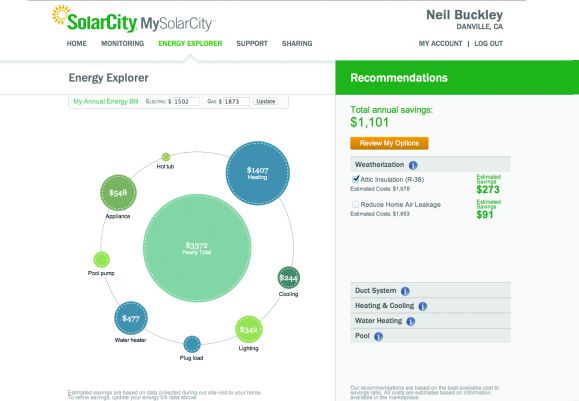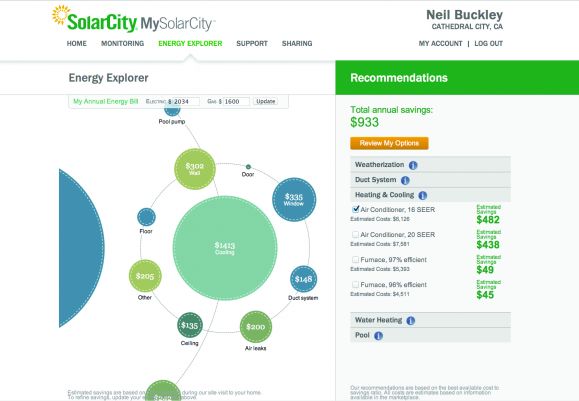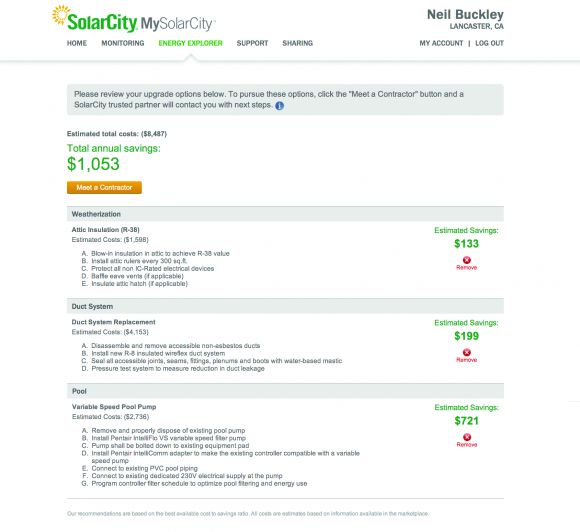After SolarCity shifted its energy efficiency strategy and pulled back from doing residential retrofits in-house, the solar services behemoth is moving straight into intelligent efficiency.
GTM's Eric Wesoff recently reported on SolarCity's evolving business plan and the resulting changes that company executives say will scale residential efficiency in the same way solar services have scaled residential solar.
But solar is very different from efficiency. For the most part, solar is very standardized and installations are uniform from home to home. Efficiency retrofits encompass an extraordinarily broad category of activities and skills. Incentives are also quite different for efficiency, making it more complicated from a financial perspective. That's why only a handful of U.S. solar contractors have offered efficiency as an in-house service.
SolarCity decided that doing the retrofit work itself was not the best way to scale. Instead, it has turned from manpower to the power of big data.
The secret sauce is a "simulation engine" that shows homeowners exactly how much they're spending on energy everywhere in their house. The initial database was created using information from 16,000 home energy audits performed over the last five years. It relies on an algorithm developed at the Department of Energy that crunches 100 million calculations per home for each individual energy efficiency audit (which is still performed by SolarCity when installing solar).
"The simulation software looks at every component in a home in relation to one another," said SolarCity COO Peter Rive. "Every ten minutes, it thinks about what one thing is doing and about its effect on the rest of the systems within the home."
The result is this simple interactive dashboard called the "energy explorer" that provides a detailed picture of energy expenditures and inefficiencies within a home. When a solar customer logs in to the SolarCity website to view the performance of their solar system and other account details, they'll also see this information:

The information is very granular. By clicking on each of the circles representing different areas of the home, the customer can further dig down into how much they're spending on energy for nearly every single piece of equipment. Each circle goes deeper into the home.
"We've assembled a one-of-a-kind database," said Rive while walking GTM through the simulation. "We can attribute every dollar to specific components. We believe SolarCity has the best database of residential energy use of anyone in the world."

The database also provides a detailed list of procedures that can be performed by a local SolarCity contractor. The customer can add different options to their account and click "meet the contractor" to have someone come to the house.
The option allows SolarCity to deepen its relationship with existing customers, gives local contractors easy leads, and provides the homeowner with an easy transaction and a quality guarantee by SolarCity.
"It's easy to engage," said Rive. "You can order a proposal with one click, all tied to your existing account. We had Amazon 1-Click in mind when we created it."

There are a couple limitations to the current offering, however. The database does not track what happens within a home after a retrofit, so SolarCity's dashboard is not nearly as accurate for homeowners who have made upgrades.
A database is only as good as the contractor doing the work. The key test will be how well the retrofits perform. However, SolarCity does not offer tracking services for home energy usage like it does with for the solar panels it installs, so homeowners won't get the same kind of performance dashboard.
Despite those initial limitations, SolarCity executives are extremely bullish on their strategy and believe they have something totally new in the market.
"This is a big breakthrough for making residential efficiency incredibly simple. Just click a button and it will happen," said Rive.
And that scale will come not from a centralized army of SolarCity employees, but from the power of big data to leverage local contractors.
"We wouldn't really categorize this as a 'big data play' in the same way you might," said Rive in response to a question about the strategy. "We're simply focused on bringing economies of scale to the industry. Big data is an enabler of that."
However one characterizes the strategy, it's a clear nod toward the promise of IT-driven efficiency as a way to scale the industry.



